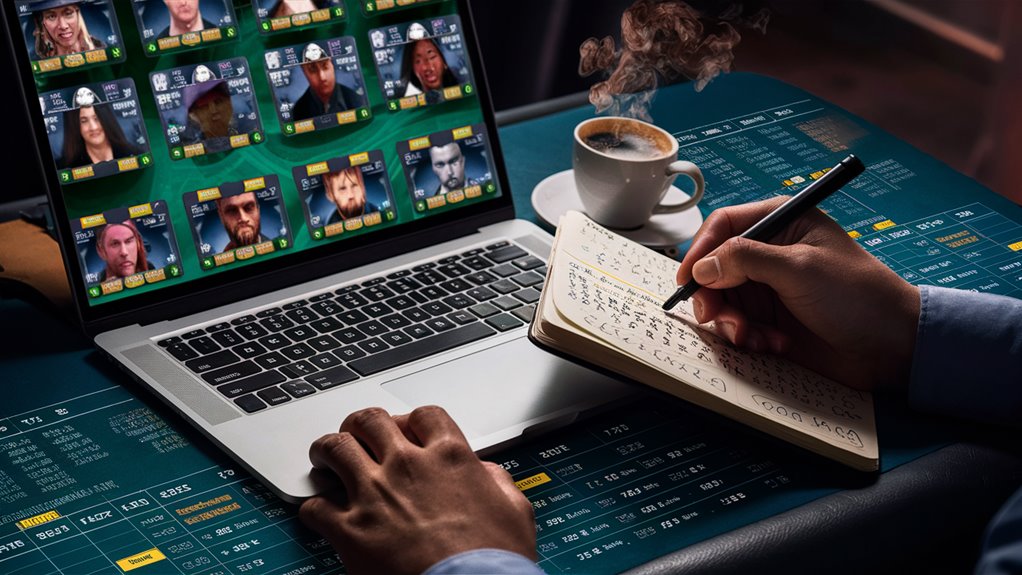How to Lift Your Poker Game Using Online Tips

Must-Have Online Tools and Software
Online poker tracking tools like PokerTracker and Holdem Manager are key for your growth in games. These strong tools show areas where you can do better and give detailed stats of how you play. It’s https://maxpixels.net/ best to use them a lot and check your game data often.
Smart Ways to Study
Put in at least 2 hours every week to study Game Theory Optimal (GTO) paths with tools like PioSOLVER. This way of learning makes your game strategies solid in math. Keep good notes on your plays and write down other player habits to build a strong store of game styles.
Basics of Managing Your Money
Managing your bankroll right is key for a long run in games. Stick to the 5% risk rule – don’t put more than 5% of your total money into one game time. Keep at least 20 buy-ins ready for your level of play to keep safe from ups and downs and stay strong in your poker career.
Practice Moves and Using Them in Live Games
Work on steady moves that fit both online and live games. Think about player timing, how they bet, and how they build their plays based on their seat. Good practice of these lets you act fast and well in games.
Getting Better at Complex Plays
Get good at the main ideas before going to more hard poker plays. Look into multi-table fight plans, ICM thoughts, and playing with a small stack. Knowing these tough parts sets the pro players apart from fun players. Keep making your play style better by always checking and changing how you play.
Mastering Online Training Tools
Basic Software and Ways to Check Your Plays
Poker tracking tools are key for true growth. PokerTracker and Holdem Manager share important clues through detailed stats, helping players see key patterns in their games. These mighty measure tools check all things like win rates, positional play, and how you make choices over many hands.
Tough Training Places
Planned training spots are at the top of poker learning. PioSOLVER and alike GTO calculators let players try out the best bet paths using smart trees of choices. When put together with full hand history check tools, these gear up a firm way to grow good after-flop choosing skills.
Set Way to Learn
Online training places change how we learn poker through long video libraries and learn-by-doing units. Winning needs you to match learning stuff to your skill level while fixing things you want to get better at. Start a fixed learning plan with:
- Often looking at stats
- Practice with making plans
- Finish learning parts fully
- Try out ideas in little bet games
- Take notes on your growth
Give at least two hours each week to focused study using these tools. Try new ideas in very small bet games before using them in usual games, making sure you add new ways well into your main game way.
Making Your Poker Knowledge Digital Store
Making Your Digital Poker Play Way Store
Setting Up a Strong Knowledge System
Putting your poker know-how in digital form is core to getting better over time. Pro poker tools and set spreadsheets are musts for listing hand histories, when you made key moves, and game ends. Put your data in main parts: before-flop ranges, after-flop moves, and how certain players act.
Writing Down Key Play Points
Writing strategy down means taking clear notes on hands and big points. Keep an eye on things like:
- Where you sit
- How much money per player
- How people bet
- Why you made a choice
- How others tend to play
- What you’re thinking
Getting Better at Using Your Data Store
Making your data store better uses a sharp tag system for fast finding of moments. Use clear tags such as:
- 3-bet pot scenes
- River bluff times
- When many play the pot
- How deep the stacks are
Keep your data true by looking at hands after playing while the game is still fresh in mind. Line up your play thoughts with solver checks to see where you might be going wrong. This full set-up makes a super tool for when you play next, holding up with what you did and figured out before.
Main Parts of Your Data Store
- Looking at hand histories
- Plans based on where you sit
- Checking how certain players act
- Math work-outs
- Guessing the value of moves you made
Seeing Online Player Moves
Smart Checks of Online Poker Player Moves

Getting to Know Digital Moves
Spotting patterns in online poker calls for good checks of digital moves that stand out from normal face-to-face signs. Watching bet patterns, timing hints, and set plays gives critical news about rivals’ game ways and how strong their hands might be.
Main Signs in Patterns
Looking at How Much to Bet
Smart bet sizing shows big patterns across different plays. Players with not same bet sizing – like 3x big blind pre-flop with top hands versus 2.5x with weaker ones – make ways you can use. These differences in betting turn into top tools to know what might come when well noted and looked at.
Timing Signs in Online Play
Digital timing patterns work as true signs of how players decide. Fast bets mostly mean plans set before, while big pauses might show true looking at hands or smart tricks. These timing marks give key ideas into how others think.
Plan-Based Moves
Acting based on seat often shows expected ways players change their game. Watching how rivals change their style based on button place shows ways you can use, especially when players show bold end-game moves but seem less sure when they face push-back.
Set-Play Finding
Set move patterns tell more in online games. Sudden changes in how decisions are made often show moving from set to hand-made play, often meaning strong hands. These changes in how fast they react give top edges when read right.
Smart Money Handling Online
Smart Money Plans for Online Poker Wins
The 5% Rule: Key to Keeping your Money Safe
Handling your money right is the base stone of keeping up wins in online poker. The main 5% rule says to never put more than 5% of all your money into one game, making a safe space from bad losses while keeping room to grow.
Smart Money Splitting
Best money split asks for planned parts across different play levels:
- Small bet games: Put 20% for base level play
- Mid level games: Use 50% for your main games
- High bet games: Keep 30% for big chances
Top Tracking and Money Wins
Checking how you do through full spreadsheet looks shows best buy-in levels and stop-loss spots. Put in place a plan to take out 25% once hitting double your first put-in, making sure your money pile grows while locking in real gains.
Set Plans for Down Times
Keeping your money during down times asks for fast cut-back on stakes. Sticking hard to set limits stops chasing losses. Keep at least 20 buy-ins for each level of play, noting online poker’s fast pace and bigger ups and downs compared to live games.
Tips on Managing Risks
- Always check on how long you play
- Look at how you’re doing every day
- Change how much you bet based on how much money you have
- Stay strong when losing many times
- Take notes on outcomes in a set way
This planned way to handle your poker money online makes sure you keep doing well and growing in online poker spots.
Making Moves to Live Games
Getting Good at Moving from Online to Live Poker
Making Pacing and Timing Work
Live poker playing asks for big changes in speed compared to online. The trick is to take your time and make moves with care. Wait at least 3-5 seconds before each move to keep even and hide how strong your hand is. Fast moves can give away too much to sharp rivals, while slow, thought-out acts keep your plans safe.
Keeping Strong at the Table
Staying strong at the table becomes key in live spots. Focus on:
- Keeping your breathing even
- Sitting the same no matter your hand
- Moving your chips and betting the same way every time
- Keeping your face still when you have to choose
Using Online Skills in Live Games
Your math skills from online give you a good edge in live games. While many live players go with gut feels, your skills with:
- Right calls on pot chances
- Thinking about hand strength
- Playing based on a range of hands Dust & Dare Bets: Merging Coarse Freedoms With Bold, Table-Pushing Finishes
bring stronger play moves. Use these skills quiet to keep your smart ways hidden.
Seeing Live Player Moves
Physical signs and how people bet give you needed info you don’t get online. Grow sharp watching by:
- Watching one player at a time when not in a hand
- Writing down clear play signs
- Keeping track of how they bet and change it
- Noting what they say and how they talk at the table
This planned way of noting player moves turns live clues into moves you can use for smart play.
